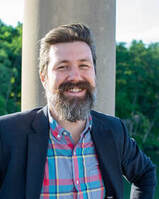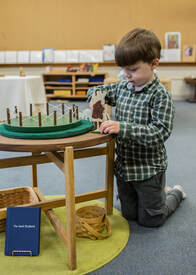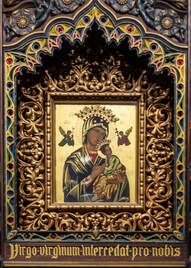 We are very happy to announce that Mark Franzen has been hired as the founding director of the Cultural Center at St. Gregory the Great. Mark comes to us from the Lumen Christi Institute, where he served as Senior Program Coordinator. He is also a long-time parishioner of St. Gregory the Great. Mark shared some of his thoughts on the mission of the Cultural Center and what it will mean for evangelization in the neighborhood. If you would like to get in touch with Mark about the Cultural Center, contact him by email. Can you speak about the significance of this role, given how long you’ve been a parishioner at St. Gregory’s? It’s God’s providence that I’m having this opportunity, and it’s fitting insofar as usually when we want to see some kind of change in the church, we want to see something right, we want to start somewhere new or go somewhere else. Being able to start a center like this in my home parish, it’s just unbelievable. It doesn’t feel like a job, it feels like a vocation. My hope is that I can live up to what is a very significant thing I’ve been called to here. My understanding of the faith has been cultivated at this parish. My wife, Lauren, and I are both baptized Catholics who returned to the faith as adults and went through the Rite of Christian Initiation for Adults at St. Gregory and were confirmed there. St. Gregory’s showcases the beauty of the Catholic faith in its architecture and art. When you come to church, what catches your eye, and how does it feed into your faith and prayer? Certainly the stained glass, which is very beautiful but also has important saints and symbols associated with those figures that can teach you things about the faith. For better or worse, [they’re] a distraction at Mass that can be instructive. It’s also the whole effect of the church. St. Gregory’s seems to be illuminated from within, in a way. The color on the ceiling, the color on the floor seems to radiate so the church has its own internal source of light, rather than light coming into the window, which to me is special and unique to St. Gregory. The high altar with the tabernacle there and the presence of Christ there is something my eye is always drawn to, and you have the Doctors of the Church depicted on the high altar. They’re figures that are always helpful to look to, whether you’re adoring the Eucharist or reflecting on the truths of the faith and the impact of the faith on your own heart. And then looking up and seeing the crucifixion depicted… that is such an important part of the faith. The sacrifice of Christ in his passion and crucifixion is something I end up looking to.  How are you thinking about continuing the legacy of St. Gregory's evangelization through the arts, to both parishioners at Mary, Mother of God, and people in the neighborhood? We’ve had this tradition of church tours, where parishioner volunteers learn about the history of St. Gregory’s and art depicted in the church and do a walkthrough survey of art in church. Something like that would be complemented by a devotional activity. So looking at the Stations of the Cross, talking about where they came from or who made them, and then praying the stations. Or on a particular feast, looking for depictions of that saint in the church, having some biographical information on the saint and those works of art as a way of enriching devotional practice. That would be a way of connecting the beauty of the objects with the goal of that beauty, which is to unite us to something beyond ourselves and to connect to those devotional practices again. Then for reaching out to people outside the parish, I think feasts and festivals are a great way to welcome people into a communal celebration that is public and open to people that may not have a deep connection to the faith. Making the church available to visit in the context of some larger festival could be a way to draw people in, and let them know it’s there. For all its beauty, it’s sort of tucked away into this residential neighborhood, and the brick façade doesn’t necessarily let you know what is inside. Can you talk about your work at the Lumen Christi Institute and how that informs what you're hoping to do at the Cultural Center? My work at Lumen Christi has focused on university and higher education, so the constituency we’re serving is primarily university students and faculty. The object is really to come into a university setting and to serve that community, so it has required cultivating a community among students and faculty but not in a way that’s separate from university life. While the institute has a mission that is one of evangelization, it’s one that is done with a friendly, collaborative attitude toward the secular university that it serves. I think understanding how to make an organization like that work and building up collaboration and good will with representatives of other organizations – people from Catholic and non-Catholic institutions – has given me an understanding of how to build something and how to have a successful institution that evangelizes through its work. Catechesis of the Good Shepherd has existed at St. Gregory’s for some time, and there’s also a strong tradition of education from the school. Can you talk a bit about the role of CGS and education in the Cultural Center, and how that will play a part in evangelization? I think the Cultural Center is a great opportunity for rethinking the parish model, in the way that Catholic families are initiated into the faith, as well as brought up into the faith. We need to think creatively about how we can make a parish home for families in this new setting. It’s not the old parochialism, where you can assume you go to the parish, the kids go to the school, and all the extracurriculars are through the parish. Through the decline in the number of Catholics and the number of faithful Catholics, Catholics are growing up in a world removed from their experience of faith. I think creating a robust community of faith where people are attracted to a community, have a sense of belonging – beyond just being there on Sunday – is really central to re-evangelizing the church. Crucial to catechetical formation is to get not only children but also parents engaged in their faith, and giving them opportunities to empower them to practice their faith as a family. It’s really essential to transmitting the faith and actually giving children the opportunity to maintain their faith into adulthood. The Catechesis of the Good Shepherd program is a great opportunity to focus children’s faith formation on contemplation and prayer, the experience of silence, the experience of the presence of the sacred as something they can learn to recognize and have an intuitive sense of, and then recognize that as something that is needed in their lives. So often people without a spiritual life become dissatisfied as adults, they grow lonely, have a sense of missing aspects of life. Being religious is essential to being a human being, and learning to recognize the presence of God and how to invite him in is extremely powerful, and a foundation for developing a mature faith. It’s also a way to get parents involved in their children’s faith formation, and it could be a way to invite families into similar experiences together as families of devotional life: saying the Rosary together, going to Adoration, having opportunities for parents or kids to share together devotional activities springing from the Catechesis program. I see that as really promising, for the Cultural Center to facilitate those sorts of things. With respect to schooling, I think the possibility of a school or some kind of educational component to the Cultural Center would also be quite promising and along similar lines of inviting families in and being a point of contact to draw them into activities of the parish and the center.  You raised this question of the need to re-evangelize even within the Church. Can you reflect more on that need, and how the Cultural Center can serve it? Pope Francis has talked about being a missionary church, and how the church everywhere is in a missionary situation. That is especially the case with baptized Catholics who don’t practice their faith or practice their faith only occasionally. I think one thing that is lost with the parochial model is the sense of belonging. If you think about work friends and college friends as your real social world, church seems less and less relevant. Then if something happens in the church or at your parish that you don’t understand or don’t like, it’s much easier to cut ties and move on. I just think about myself being a Chicagoan my whole adulthood and being spread thin, and what I wanted, which is a thick community of faith, in which you can have spiritual friendship and a sense of belonging – and a sense of obligation as well. That’s the other thing about the average parish experience now. I think most parishioners don’t have a sense of obligation: “If I didn’t show up here next week, nobody would care and I wouldn’t feel responsible to anyone.” But a real faith community has this level of accountability, where if someone doesn’t see you and you’re supposed to be doing something, they’ll be knocking on the door. So I think it’s an opportunity for lay people to step up in the church, and thinking creatively and proactively about how we can kind of create these communities and structures, without depending on a pastor or bishop to do this for us. How do you see the Cultural Center fitting into the new parish of Mary, Mother of God, given the three-church structure we have here? There are things about the parish situation where St. Gregory the Great can complement the other churches. Silence, cultivating the sacred, and the presence of God: I think a lot of activities of the Cultural Center will be geared to that. But I think it will be important to connect people in their lives of prayer and devotion to the moral life we’re called to in light of our prayer and faith; that is: service, charity, being concerned about the plight of the marginalized. As Catholics we’re called to a life of contemplation and action. I hope the center can be a practical training ground of the complementarity of those two things.
0 Comments
Leave a Reply. |
Archives
June 2024
CategoriesAll Canterbury House Catechesis Of The Good Shepherd Intellectual Life News Profiles Sacred Art Sacred Music |
|
|
|
|
 RSS Feed
RSS Feed
